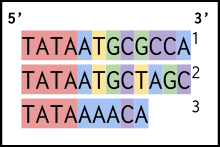TATA box

1. E.Coli a70 Promoter BBa_J010062 - Pribnow box
2. E. Coli a70 Promoter BBa_J231083 - Pribnow box
3. Yeast Promoter BBa_K122000 - TATA box
Promoter codes and names were found on: [1]
In molecular biology, the TATA box (also called the Goldberg-Hogness box)[2] is a DNA sequence (cis-regulatory element) found in the promoter region of genes in archaea and eukaryotes;[3] approximately 24% of human genes contain a TATA box within the core promoter.[4]
Considered to be the core promoter sequence, it is the binding site of either general transcription factors or histones (the binding of a transcription factor blocks the binding of a histone and vice versa) and is involved in the process of transcription by RNA polymerase.
The TATA box was first identified in 1978 by American biochemist David Hogness and his lab.[5]
Overview
The TATA box has the core DNA sequence 5'-TATAAA-3' or a variant, which is usually followed by three or more adenine bases . It is usually located 25-35 base pairs upstream of the transcription start site. The sequence is believed to have remained consistent throughout much of the evolutionary process, possibly originating in an ancient eukaryotic organism.[6][7]
During the process of transcription, the TATA binding protein (TBP) normally binds to the TATA-box sequence, which unwinds the DNA and bends it through 80°. The AT-rich sequence of the TATA-box facilitates easy unwinding, due to weaker base-pairing interactions between A and T bases, as compared to between G and C. The TBP is an unusual protein in that it binds to the minor groove and binds with a β sheet.[8]
The TATA box is usually found at the binding site of RNA polymerase II. TFIID, a transcription factor, binds to the TATA box, followed by TFIIA binding to the upstream part of the TFIID protein. TFIIB then binds to the downstream part of TFIID. RNA polymerase can then recognize this multi-protein complex and bind to it, along with various other transcription factors such as TFIIF, TFIIE and TFIIH. Transcription is then initiated, and the polymerase moves along the DNA strand, leaving TFIID and TFIIA bound to the TATA box. These can then facilitate the binding of additional RNA polymerase II molecules.
This cluster of RNA polymerase II and various transcription factors is known as a basal transcriptional complex or BTC. In this state, it only gives a low level of transcription. Other factors must stimulate the BTC to increase transcription levels. One such example of a BTC stimulating region of DNA is the CAAT box.
Most genes lack a TATA box and use an initiator element or downstream core promoter instead.[9] Nevertheless, TBP is always involved and is forced to bind without sequence specificity. A genome-wide study put the fraction of TATA-dependent human promoters at ~10%.[10] An earlier study of ~1,000 genes found 32% of the promoters had a TATA box.[11]
See also
References
- ↑ http://parts.igem.org/Promoters/Catalog/Constitutive
- ↑ Lifton RP, Goldberg ML, Karp RW, Hogness DS (1978). "The organization of the histone genes in Drosophila melanogaster: functional and evolutionary implications". Cold Spring Harb Symp Quant Biol. 42: 1047–1051. doi:10.1101/sqb.1978.042.01.105. PMID 98262.
- ↑ Smale, ST; Kadonaga, JT (2003). "The RNA polymerase II core promoter." (PDF). Annual Review of Biochemistry. 72: 449–79. doi:10.1146/annurev.biochem.72.121801.161520. PMID 12651739.
- ↑ Yang, C; Bolotin, E; Jiang, T; Sladek, FM; Martinez, E (2007). "Prevalence of the initiator over the TATA box in human and yeast genes and identification of DNA motifs enriched in human TATA-less core promoters.". Gene. 389 (1): 52–65. doi:10.1016/j.gene.2006.09.029. PMC 1955227
 . PMID 17123746.
. PMID 17123746. - ↑ Lifton, R. P.; Goldberg, M. L.; Karp, R. W.; Hogness, D. S. (1978). "The Organization of the Histone Genes in Drosophila melanogaster: Functional and Evolutionary Implications". Cold Spring Harbor Symposia on Quantitative Biology. 42: 1047–1051. doi:10.1101/SQB.1978.042.01.105.
- ↑ Patikoglou, G. A.; Kim, J. L.; Sun, L.; Yang, S.-H.; Kodadek, T.; Burley, S. K. (15 December 1999). "TATA element recognition by the TATA box-binding protein has been conserved throughout evolution". Genes & Development. 13 (24): 3217–3230. doi:10.1101/gad.13.24.3217. PMID 10617571.
- ↑ Bernard, Virginie; Brunaud, Véronique; Lecharny, Alain (2010). "TC-motifs at the TATA-box expected position in plant genes: a novel class of motifs involved in the transcription regulation". BMC Genomics. 11 (1): 166. doi:10.1186/1471-2164-11-166.
- ↑ Kutyavin, I. V.; Afonina, I. A.; Mills, A.; Gorn, V. V.; Lukhtanov, E. A.; Belousov, E. S.; Singer, M. J.; Walburger, D. K.; Lokhov, S. G.; Gall, AA; Dempcy, R.; Reed, M. W.; Meyer, R. B.; Hedgpeth, J. (15 January 2000). "3'-minor groove binder-DNA probes increase sequence specificity at PCR extension temperatures". Nucleic Acids Research. 28 (2): 655–61. doi:10.1093/nar/28.2.655. PMC 102528
 . PMID 10606668.
. PMID 10606668. - ↑ Yang, C.; Bolotin, E.; Jiang, T; Sladek, F. M.; Martinez, E. (1 March 2007). "Prevalence of the initiator over the TATA box in human and yeast genes and identification of DNA motifs enriched in human TATA-less core promoters". Gene. 389 (1): 52–65. doi:10.1016/j.gene.2006.09.029. PMC 1955227
 . PMID 17123746.
. PMID 17123746. - ↑ Carninci P, Sandelin A, Lenhard B, et al. (June 2006). "Genome-wide analysis of mammalian promoter architecture and evolution". Nat. Genet. 38 (6): 626–35. doi:10.1038/ng1789. PMID 16645617.
- ↑ Suzuki Y, Tsunoda T, Sese J, et al. (May 2001). "Identification and characterization of the potential promoter regions of 1031 kinds of human genes". Genome Res. 11 (5): 677–84. doi:10.1101/gr.164001. PMC 311086
 . PMID 11337467.
. PMID 11337467.